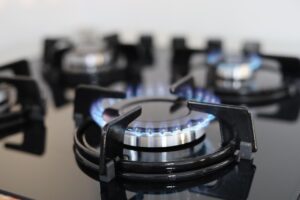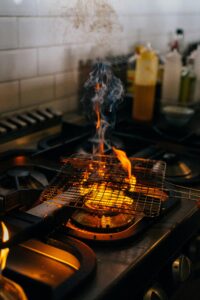7 Reasons Your Gas Stove Is Not Heating Properly – You Need to Check Today
I still remember the frustration I felt one chilly morning when my tea just wouldn’t boil. I stood there watching, wondering, “Why is my gas stove not heating properly?” The flame looked weaker than usual, and no matter how high I turned the knob, the heat just wasn’t enough. And trust me, as someone who cooks daily, a weak flame can ruin not just your food, but your entire day.
If you’re facing the same issue — your gas burner is acting up, taking ages to heat or just refusing to cook evenly — you’re not alone. Many home cooks deal with this, and the causes are often simple but easily overlooked.
In this post, I’ll walk you through 7 common reasons your gas stove isn’t heating properly — including blocked burners, misaligned parts, and even gas supply issues. I’ll also share quick fixes and helpful tools that saved me — like this non-scratch scrub sponge, I now swear by!
Contents

1. Clogged Burner Head (Most Common Culprit)
The burner head is where your flame forms and it needs to be clean and free from grease. Over time, food particles, oil, or even detergent residue can block the tiny holes — especially if you’re cooking spicy Indian food like I do!
If your flame looks uneven, flickers, or is too low, grab a soft bristle cleaning brush and gently scrub the burner head. You’ll be amazed how a 2-minute cleaning can restore full power.
Pro Tip: Soak the head in warm water with a drop of grease-cutting kitchen spray before brushing.
2. Misaligned Burner Cap
This one’s sneaky. A slightly off-center burner cap can mess with the gas-air mix, which directly affects how hot your stove gets. I once spent hours trying to fix the flame, only to realize the cap was tilted after a deep clean.
Remove the cap, realign it properly, and light the stove again. You’ll often see an instant improvement.
3. Weak Gas Supply or Low Pressure
Let’s not forget the gas itself. If your stove suddenly starts underperforming, the issue might be a low gas cylinder or faulty gas line. Once, my LPG was nearly empty — it still lit up, but the flame was weak and lazy.
Check your cylinder weight, valves, and gas pipe. If needed, call your gas provider to verify if the supply is consistent.
You can also install a gas safety valve with a regulator that alerts you to low flow — available on Amazon as a “kitchen gas safety regulator.”
4. Dirty Air Shutter
Ever heard of the air shutter? It’s a small adjustable opening under the burner that mixes air with gas. When clogged with soot or debris, it affects the flame strength.
If your gas stove is not heating properly, look underneath and clean the shutter area gently using a deep cleaning kitchen cloth.
5. Faulty Control Valve
When your stove knob turns, it controls a valve that regulates gas flow. If that valve is damaged or sticky, it may not let enough gas through even if the knob is on high.
This happened to my friend, who thought her entire stove was broken. A local technician replaced the valve for ₹200 — and it worked like new.
6. Burner Grates or Pans Warped Over Time
The metal parts supporting your cookware can warp or rust, making your pot sit unevenly. That means improper contact with the flame — and uneven or weak heating.
Check if the pan is wobbling. If yes, it’s time to replace your grates. I personally switched to a “heavy-duty gas stove grate” I found on Amazon, and it made a big difference.
7. Moisture Inside the Burner
If you’ve recently deep-cleaned your stove, moisture trapped in the burner could be the issue. I learned this the hard way — after wiping everything down, I tried cooking dal and ended up waiting 45 minutes!
Remove the burners and let them dry fully in the sun or under a fan. You can even use a hairdryer for quick drying.
Final Thoughts: Fixing a Gas Stove That Won’t Heat Properly
If your gas stove is not heating properly, it doesn’t mean it’s broken. Most of the time, it’s something small — dirt, moisture, alignment, or low gas flow. And thankfully, most of these can be fixed at home in under 15 minutes.
Personally, I now keep a few essentials handy in my kitchen drawer — like a non-scratch scrub sponge, a grease-cutting kitchen spray, and a soft bristle cleaning brush — so I’m never caught off guard again.




